- Fountain Pen Board / FPnuts
- → J Appleseed's Content
J Appleseed's Content
There have been 23 items by J Appleseed (Search limited from 20-April 23)
By content type
See this member's
#2754 An oddity (Sheaffer TD Cadet. 1960 not 1950?)
![]() Posted by
J Appleseed
on 05 November 2010 - 05:02 PM
in
SHEAFFER (USA "Big Five")
Posted by
J Appleseed
on 05 November 2010 - 05:02 PM
in
SHEAFFER (USA "Big Five")
VINTAGE LOT SHAEFFER CADET FOUNTAIN PENS
John
#2752 An oddity (Sheaffer TD Cadet. 1960 not 1950?)
![]() Posted by
J Appleseed
on 05 November 2010 - 04:43 PM
in
SHEAFFER (USA "Big Five")
Posted by
J Appleseed
on 05 November 2010 - 04:43 PM
in
SHEAFFER (USA "Big Five")
And another one. Gray pen with white trim. Black section
http://cgi.ebay.com/...=item1e5f68b5eb
d
That is an ordinary Cadet with what appears to be an M1 standard steel nib. Garden variety.
Perhaps a quick overview of the tip-dips is in order.
The Cadet originally appeared (per Jim Mamoulides) in 1952, with the following:
Torpedo-shaped touchdown filling system, nearly identical to TM touchdown.
White trim with single band, similar to Admiral
Tip-dip feed
Steel nib with "N"1 designation (F1, M1, etc)
Black section.
Colors in Black, Burgundy, Pastel Green, Pastel Blue, grey.
Polished steel cap.
Section same as body color
Available in Burgundy, Blue, Sage Green, Black and Vermillion.
14K gold nib marked 23 on tip-dip feed
Gold trim, similar to admiral.
Had same-color section as late Cadet
Steel nib, silver trim, black section is probably the most commonly found varient of the cadet.
I have a low-priority collection of these - slowly working on all tip-dip varients, but only if they are cheap. So far I have all of the early black-section cadets, most of the craftsman, and a few of the late cadets. Still working on a Cadet 23
John
#2134 Couple interesting Sheaffer 1940's post-War ads.
![]() Posted by
J Appleseed
on 28 September 2010 - 04:40 PM
in
SHEAFFER (USA "Big Five")
Posted by
J Appleseed
on 28 September 2010 - 04:40 PM
in
SHEAFFER (USA "Big Five")
(emphasis added).Too, we might need to tweak your three term schema to be specific:
- post-war celluloid
- post-war pre-touchdown injection-molded plastic
- post-war (pre-TM) Touchdown
I am not sure we need such a complicated term for #3. There were no war-era or pre-war Touchdowns, so it is really not necessary to list that (unless we are talking about Korea or some other war than "The" war). Really all we need is Touchdown and TM Touchdown, but some designation of "pre-TM" might be useful for clarity.
John
#2099 Keene pen of NY. Black Hard Rubber. Info?
![]() Posted by
J Appleseed
on 27 September 2010 - 03:33 PM
in
USA "Other": Bexley; Cross; Esterbrook; Carter, Chilton, Moore, Leboeuf, Dunn, Triad, etc.
Posted by
J Appleseed
on 27 September 2010 - 03:33 PM
in
USA "Other": Bexley; Cross; Esterbrook; Carter, Chilton, Moore, Leboeuf, Dunn, Triad, etc.
Can't remember much more than that without the reference. I know they had a cosy relationship, with Mr. Keene taking Finestone's secretary on a cruise or something along those lines. Keene pens often have the Klien clip, but I think they usually have a Keene nib.
I have a RMHR Keene with a broken clip and a RHR Keene with a cracked barrel. Both large, high-quality pens, with excellent nibs. I would speculate that they are early production for Eclipse, before Eclipse went to hard-core rolled celluloid production (Finestone I believe had a patent for a method of rolling sheet-stock into tubes, allowing them to push inexpensive celluloid flat-tops) but they may have made hard-rubber pens alongside the rest.
John
#1987 More '40s Sheaffer's Novice Questions
![]() Posted by
J Appleseed
on 20 September 2010 - 05:16 PM
in
SHEAFFER (USA "Big Five")
Posted by
J Appleseed
on 20 September 2010 - 05:16 PM
in
SHEAFFER (USA "Big Five")
The article from the 1942 Billboard Magazine that I posted in this thread, says:
W.A. Sheaffer Pen Company is one of the few companies that is still producing low-priced pens but has stopped making pencils altogether because of its munitions production.
From this quote (which certainly is not overly precise), I would have guessed that Sheaffer did continue to produce some non-Lifetime pens... (though probably as a small percentage of their pre-war levels).
1942, or 1943? One does have to remember that 1942 was the first year of serious US involvement in the war. They may have started out with more limited munitions conversion and then converted more of the production line as the war went on. But, of course, there would need to be more documentation.
#1986 A "problem" 1940's Sheaffer Crest on ebay?
![]() Posted by
J Appleseed
on 20 September 2010 - 05:06 PM
in
Elements of Collecting: Hunting, Valuing and Polemicizing
Posted by
J Appleseed
on 20 September 2010 - 05:06 PM
in
Elements of Collecting: Hunting, Valuing and Polemicizing
John
#1920 Sheaffer nib codes
![]() Posted by
J Appleseed
on 15 September 2010 - 05:04 PM
in
SHEAFFER (USA "Big Five")
Posted by
J Appleseed
on 15 September 2010 - 05:04 PM
in
SHEAFFER (USA "Big Five")
John;
Keep in mind that the cheap snorkel special is an open silver palladium nib so it was fairly low brow. The top nibs were two toned 14K nibs.
Roger W.
And essentially the same "short-sheeted" PdAg nib shows up on the Imperial II and the Stylist (long skinny clip, may have white "S" instead of white dot; also seen with the flat nib sorta resembling the Parker 180). Also, reverse mask plated (gold over the Pd-Ag, so it looks like a two tone gold nib) on the Sheaffer Target and Imperial III.
I can see the silver-palladium nibs as being lower-tier than 14K, and I know they showed up on the Imperial II and a few others, but this one is basically the lowly "Cartridge Pen" with a slightly fancier cap and conical nib. I don't think there was a comperable gold-nibbed version, only steel. That is what makes it seem an oddly low-brow pen for a silver-pd nib.
On the other hand, as a production issue I can see it making more sense to use existing process and tooling for an AG-PD nib rather than retooling to put out conical steel nibs - particularly if the steel made it harder to work with.
John
#1919 Sheaffer Snorkel. Does it really write more words than do larger pens?
![]() Posted by
J Appleseed
on 15 September 2010 - 04:48 PM
in
SHEAFFER (USA "Big Five")
Posted by
J Appleseed
on 15 September 2010 - 04:48 PM
in
SHEAFFER (USA "Big Five")
Furthermore, though the size of the moon does not change, the angle subtended by the moon at the horizon in the vertical dimension is, in fact, smaller than when it is high in the sky. This is not an illusion.
--Daniel
Technically, I believe that optical illusions are divided into 3 main types:
Physical illusions, which are optical effects caused by the physical properties of light and the interaction of light and objects (eg the way a stick appears to bend when it enters water due to refraction; heat ripples; mirage)
Physiological illusions, which are caused by the physiology of the eye and neural processing of visual information (eg. the blind-spot effect, false-color after images, etc.)
Cognitive illusions, which are caused by the cognitive interpretation of visual information based on learned and assumed experience (eg, pictures that shift between a duck and rabbit depending on how you interpret the picture; distortions caused by false perspective).
The visual angle subtended by the moon at the horizon would fit neatly as a physical illusion. The illusion that the moon appears to be larger at the horizon is a cognitive one.
John
#1918 Should students still be taught cursive writing?
![]() Posted by
J Appleseed
on 15 September 2010 - 04:21 PM
in
Miscellanea: Ink, Paper, Calligraphy, Journals, Storage, Turning, etc
Posted by
J Appleseed
on 15 September 2010 - 04:21 PM
in
Miscellanea: Ink, Paper, Calligraphy, Journals, Storage, Turning, etc
I do believe children should still be taught handwriting. Should we follow a handwriting curriculum that involves teaching children to write in a rigid stick-and-ball print and then teach them to write all over again in a completely different way two years later? Do we have to use roundhand-derived styles that are overly looped, excessively slanted, and tend to degrade into illegibility faster than other styles? I think we would be much better off with a more traditional italic-derived style, which could be joined naturally to increase speed.
John
#1896 Sheaffer nib codes
![]() Posted by
J Appleseed
on 14 September 2010 - 04:06 PM
in
SHEAFFER (USA "Big Five")
Posted by
J Appleseed
on 14 September 2010 - 04:06 PM
in
SHEAFFER (USA "Big Five")
John
#1606 Blissful Ignorance: Variants of TM Touchdown not seen before
![]() Posted by
J Appleseed
on 02 September 2010 - 03:42 PM
in
SHEAFFER (USA "Big Five")
Posted by
J Appleseed
on 02 September 2010 - 03:42 PM
in
SHEAFFER (USA "Big Five")
I think Sears used "Tower" to relabel items from other manufacturers from the period, sell under the brand name, for instance, they did it with camera's during the period, to name one, Asahi (pentax) cameras from the early 50's into the about 1960~ can be found labeled "Tower"
Certainly - it was one of their widespread house brands, to celebrate the Sears Tower. I believe it first appeared in the late 30s - early 40s, with pens labelled "Tower Truepoint". Later in the 1950s it was used on lower-end pens. I have no idea who made them - the (plated) nibs and feed are decent if the rest of the pen iffy.
Interestingly, in the 1920s-1930s, Sears seems to have used a number of brands for different tiers of specific products - there was not, for instance, Diamond Medal pencil sharpeners or cameras. Later, they seem to have adopted fewer brand names with broader use (Kenmore appliances, Craftsman tools, Tower office supplies and cameras and some other things).
John
#1605 A National combo
![]() Posted by
J Appleseed
on 02 September 2010 - 03:31 PM
in
Post Your Pen Finds
Posted by
J Appleseed
on 02 September 2010 - 03:31 PM
in
Post Your Pen Finds
John
#1552 An Odd Pen Set?
![]() Posted by
J Appleseed
on 01 September 2010 - 03:44 PM
in
Post Your Pen Finds
Posted by
J Appleseed
on 01 September 2010 - 03:44 PM
in
Post Your Pen Finds
These balance-like Equipose pens have been the subject of much discussion by pen historians. The assumption is that Eversharp first came up with this design as a counter to Sheaffer's Balance pens, then quickly shifted their design in response to legal threats from Sheaffer. I believe the less-balance-life designs were out within 18 months of the initial balance-like ones. To date there is no documentation of legal action by Sheaffer, but we presume that a company of Sheaffer's size and known zelousness in protecting their patents would not have allowed such a blatent infringment of their design patent (the action would have been in the form of a cease-and-desist letter from their legal counsel and could have easily never have gotten to the point of filing a formal suit, so the lack of formal legal action is not proof that there was no legal threat). A lot more could be said about this topic.
What I find interesting is that Eagle also copied the balance design almost completely. The pen is a discolored black-and-pearl, which would more likely date it to around the time of the introduction of the Balance, rather than many years later after Sheaffer's patent had expired. It is clearly marked "Eagle Pencil CO." on the clip. Another interesting pen in relation to the post-balance era.
John
#1440 Blissful Ignorance: Variants of TM Touchdown not seen before
![]() Posted by
J Appleseed
on 27 August 2010 - 03:32 PM
in
SHEAFFER (USA "Big Five")
Posted by
J Appleseed
on 27 August 2010 - 03:32 PM
in
SHEAFFER (USA "Big Five")
John
#1168 Graphic Fountain Pen ?
![]() Posted by
J Appleseed
on 11 August 2010 - 10:58 PM
in
Post Your Pen Finds
Posted by
J Appleseed
on 11 August 2010 - 10:58 PM
in
Post Your Pen Finds
Thanks for the long summary of what you know on the subject, which I think fits with my recollection of what you have said elsewhere. As David mentions, it is unfortunate when someone holds information tightly and then takes it to the grave. One hopes anything solid will turn up in his papers, and that it will eventually come to light. But Fultz was also the foremost expert on Chicago area pen companies and I am inclined to give that some credance, in the absence other evidence.
I am ready to believe that National existed and sourced parts from Barrett. As I mention, some of the Gold Medal pens do bear the National Pen Products Co. imprint, and I think I have also seen one of the Lincoln pens with that name. There are also some pens with a Barrett or C.E. Barrett Co. imprint. All have that relatively classic design that we have come to call "National" - lever fillers, flat-top or stepped ends, and a distinctive lever.
The Pencraft that I picked up (now in Dennis Bowden's collection) which is also identical to the "National" pens is the one that really made me wonder. I have also seen some Belmont pens, which was an M-G brand, listed as "National". It made me realy wonder how many of the "National" pens could really be linked to National by solid evidence. I suspect George K. is right that C.E. Barrett co is the maker of parts for all of these pens (which he claimed in a post at Lion and Pen which we hope will some day return), but I am not sure that we can link the assembly to National in all but a few cases.
A few other points of interest. The 1937 Index of Trademarks lists a "Fred J. Williams, Doing Business as National Pen Co, St. Louis. MO".
Also there is another "National Pen and Pencil Co." of Shelbyville TN, which is still alive today under the National Pen Co. name as a dealer in promotional items, and historically as the manufacturer of the Tuckersharpe pens (or at least owner of the trademark). They are, to the best of my knowledge, completely unrelated.
John
#1151 Graphic Fountain Pen ?
![]() Posted by
J Appleseed
on 11 August 2010 - 03:47 PM
in
Post Your Pen Finds
Posted by
J Appleseed
on 11 August 2010 - 03:47 PM
in
Post Your Pen Finds
1. Documentation about the alleged National Pen Co. or National Pen Products Co. of Chicago seems to be significantly lacking. Most of the speculation that I have seen sources to what I call collector oral history (which I don't discount out of hand - it is often inaccurate and baseless speculation, but also can have roots in the memories of people involved in the original manufacture who have now passed on without a published record of their experiences). Much of it seems to source with Michael Fultz, who well might have had documentation. (and Dave, I know you had some conversations with Fultz about this subject, so maybe you can validate what knowledge he shared).
2. To my knowledge, only a couple of alleged National pens actually have the National name. The Gold Medal (not Gold Bond) can be found to have the inprint "National Pen Products Co." I think I have seen (but do not collect or posess - so take with appropriate salt) some "Lincoln" or "New Lincoln" pens with some sort of "National" imprint. Good Service, Webster, Diamond Medal, Gold Bond, and several of the other pens that are lumped as National brands do not posess any sort of National Imprint.
3. The relationship between National and C.E. Barrett remains very unclear - did National source parts for several brands, or are the similarities of parts due to the C.E. Barrett Co.?
4. I have seen Michael-George (Kraker) Co. pens (Pencraft, mainly) that were dead ringers for "National" pens. We know that M-G had an assembly plant and pushed a lot of pens over the years. It is conceivable that some of the brands we assume to be National were actually M-G Co. It is also possible that M-G sourced some parts or pens from C.E. Barrett, or even from National.
In short, there are a lot of unknowns, which is why I often preface such comments as "presumptive National Pen Products Co." brand or some such.
Of course, this one seems to be some sort of Canadian version of National. While National Pen is not an uncommon name, the similarity in design leads one to think this is the same company - perhaps a Canadian subsidiary to get around Tariff laws.
John
#1124 1930's Parker Sears connection. Rebadged Parker (exc Vac-Fil)
![]() Posted by
J Appleseed
on 10 August 2010 - 08:18 PM
in
PARKER: (USA "Big Five")
Posted by
J Appleseed
on 10 August 2010 - 08:18 PM
in
PARKER: (USA "Big Five")
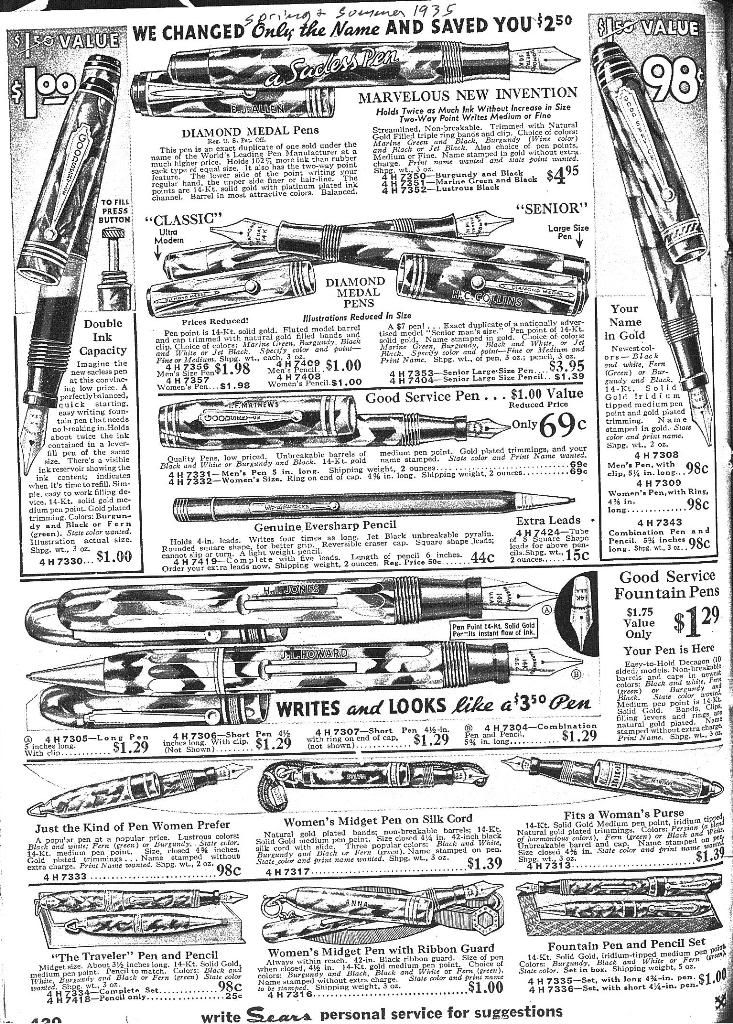
I will double-check the files at home, but to my memory, the fluted DMs appear only in the Spring 1935 catalog. I do not have 1934 catalogs to see if they appear there as well (I would assume that they make an appearance in Fall 1934/Winter 1935, as Sears tended to put out a larger catalog with more items with gift-potential in the Fall catalogs for the Christmas season). Colors are the 4 shown above in David's picture - Marine Green, Burgundy, Black and White, and Jet Black (note the names vs Parker names for the same colors).
The Fall 1935 catalog makes no mention of a fluted barrel, but does continue to offer a "Vac-Fil" Diamond Medal and a "Sac-Fil" Diamond Medal - the latter for $1 less than the former. No picture is provided to show the sac-fill, so it might be fluted, or might not.
The Fall 1936 catalog makes no mention of a Sac-filler Diamond Medal.
Also of note - Sears used the faceted "Parkette" barrells in Good Service lever filler pens as well - note the Spring 1935 catalog (above) or the Fall/Winter 1936/1937 Good Service pens in the other DM thread.
I really need to get down to the library and fill in the blanks on these catalogs. . .
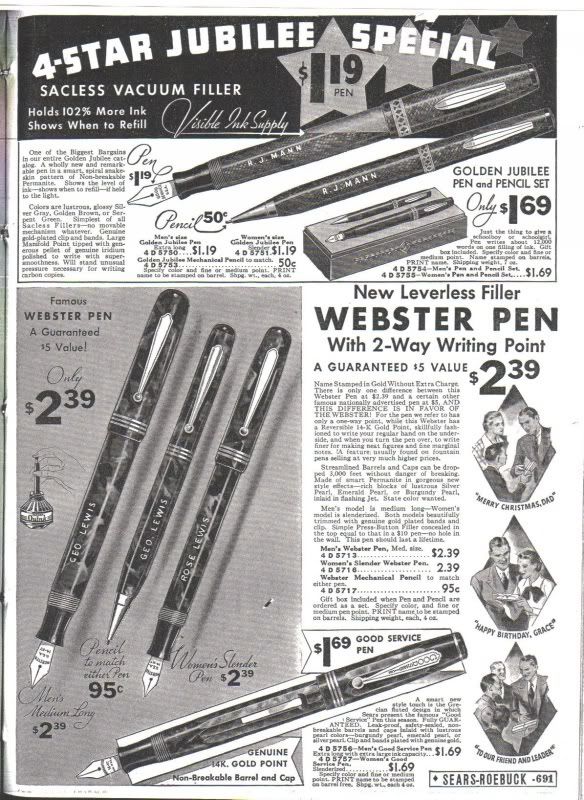
John
#993 Pics o' the gold brick. Funky Parkers from the 'thoities,
![]() Posted by
J Appleseed
on 05 August 2010 - 04:00 PM
in
PARKER: (USA "Big Five")
Posted by
J Appleseed
on 05 August 2010 - 04:00 PM
in
PARKER: (USA "Big Five")
David,
Do you, or anyone know if there are any DM's and such in the Parker Archives? That would be something.
The colors and patterns are a very difficult topic to understand (at least to me) regarding the plastics in the pen world at the time. Or is it that the color spectrum for these pens are huge, and isolating every color, both Parker and other brands, would be daunting and impossible? hmmmm....
Regards,
George
It would be a huge, but fruitful, undertaking to map out all of the plastic patterns used at the time. We know that most pen companies bought celluloid stock from major chemical companies like DuPont. Larger companies appear to have obtained exclusive patterns for many of thier pens - think the Sheaffer or Parker striped patterns - but other patterns show up across multiple brands and manufacturers, and still other patterns show up in slightly different forms from differen manufacturer. Doing a photo-study of a few thousand pens to try to document which companies likely got rod-stock from the same source, and which companies used copy-cat patterns would be an interesting and valuable project.
John
#971 Pics o' the gold brick. Funky Parkers from the 'thoities,
![]() Posted by
J Appleseed
on 04 August 2010 - 04:42 PM
in
PARKER: (USA "Big Five")
Posted by
J Appleseed
on 04 August 2010 - 04:42 PM
in
PARKER: (USA "Big Five")
Regarding your presentation, I have only one caveat: the Webster in the image above is not, per se, a rebadged Challenger.
The Good Service shown appears to be a rebadged Parker Parkette Deluxe, but the Webster (assuming button filler; i have the same ad will post in larger form if have quiet minute) shows a side clip (presumably tabs, maybe a "Z") not the washer clip of the a Challenger. The top of the cap in the image above looks to be a fused black end not a threaded removable part. Basically, the cap looks to be Parkette (non Deluxe, 1935-6-ish) derived. Here is a Parker Parkette superimposed on your ad[...]
That said, some of the earlier Diamond Medal pens show clear derivation from Challenger family, albeit with some tweaks on plastic used. If this one has button filler (again, ad too small, though I have my larger copy to post later), then it is a style mix-- as the Parkette shown, though it resembles the Webster, is lever filler-- a theme that will be driven home solidly regarding your fluted pen shown earlier.
And, there are Websters derived from Challenger-like pens of course, though they perhaps can be more specifically attributed to derivation from... Parker Televisor ( a quite Challenger-like pen itself) rather than from Challenger, proper. More on that a bit later too.
regards
David
I would agree - I was using Challanger incorrectly. The Websters shown in that ad are button-fillers, so really they represent a mix of Parkette and other depression-era styles.
Your image of the DM's with top clip insertion (which to me vaguely evoked Rider, but now I'm not so sure), in Sears catalogues at least puts to rest my concern I'd seen that ad elsewhere (I suppose I still might have...).
The Diamond Medal Comrade pens, with the funky top-clip insertion, otherwise have classic features of the presumptive National/Barrett source pens - particularly the lever box. While I am not convinced that we know these were produced by National (maybe Fulz had some paper that showed it, but I have not seen it), I think they clearly were by the same manufacturer as the rest of the DM pens at the time.
Impressive, though perhaps not surprising, that Sears made catalogue variants for what they perceived to be different markets.
It may have been motivated as much by supply-chain issues and factors with stocking the different warehouses as it was by targetting regional markets. I am not sure. One of my projects for some point in the future is to dig into more of the extensive history of the Sears company and how it operated. One of the challenges for all of us in researching pen history is that pens were not produced in a vacuum (not even vac-fils). They were part of a number of trends in industrial, business, and legal development. Understanding the industrial background of the time, particularly in regards to things like transportation and distribution networks, sales and marketing strategies, and cultural trends, is crucial in putting a lot of pen developments in context (or in other words, I really need to brush up on my industrial history.)
John
#970 Pics o' the gold brick. Funky Parkers from the 'thoities,
![]() Posted by
J Appleseed
on 04 August 2010 - 04:29 PM
in
PARKER: (USA "Big Five")
Posted by
J Appleseed
on 04 August 2010 - 04:29 PM
in
PARKER: (USA "Big Five")
While lunchtime projects and using old stock are certainly possibilities, I think it just as likely that Parker did up some prototypes of new rod-stock before they decided which patterns to use for Parker, and which to offer to Sears or other companies.
I do note that there are no Diamond Medals in standard Parker top-line colors. There are colors unique to the DM line, and some overlap with the Jr. and Challanger/Televisor/Moderne patterns. Parker clearly did not want to devalue the uniquness of the top-line patterns, but seems to have been willing to have some overlap with the lower line.
Also, I would be really interested in comparing that odd striped vac to some Truepoint and Eagle stock I have seen.
John
#953 Pics o' the gold brick. Funky Parkers from the 'thoities,
![]() Posted by
J Appleseed
on 03 August 2010 - 04:14 PM
in
PARKER: (USA "Big Five")
Posted by
J Appleseed
on 03 August 2010 - 04:14 PM
in
PARKER: (USA "Big Five")
37 to 38 pages of catalogue material or catalogued material from '37-8? I have some of the latter, but concede I do not have the former
Both - I meant the '37 and '38 catalogs, but I have at least 38-40 pages of catalogs, probably much more. It's a pretty thick file at this point. As mentioned, the entire run of the Sears catalog is sitting down at the Seattle Public Library, main branch (6th floor) but I have not had the time to scan it all. I have scanned the relevant pages from the hardbound versions that they have (which are less complete, though much better quality images). Interestingly, the Microfilm is the Chicago catalog, while the hardcopy catalogs are the Seattle Version - they had different catalogs for items shipping from their 4 different local distribution warehouses, and the catalogs are different during some years. Even the pens in the Seattle Catalog are different from those in Chicago Catalog, during some years (not the 30s, however).
(I assume you have gotten ahold of the few copies at the Onadago Public Library? They have a few catalogs in the catalog).
John
#952 Pics o' the gold brick. Funky Parkers from the 'thoities,
![]() Posted by
J Appleseed
on 03 August 2010 - 04:01 PM
in
PARKER: (USA "Big Five")
Posted by
J Appleseed
on 03 August 2010 - 04:01 PM
in
PARKER: (USA "Big Five")
Let me apologize for asking a dumb question... Were Diamond Medal available only through Sears, or where they an independent company that was sold primarily through Sears? I ask, after seeing the Websters and Good Service pens featured in the catalogue ads (these brands I know were independent companies). Again, sorry for the stupid question, but this era is a decade or two or three later than I know much about.
Dave
I think the answer to this question is important. If Diamond Medal is availible only through Sears, it makes it more likely (though of course does NOT extablish it as fact) that Sears held the Trademark for the Diamond Medal name. Another relevant question is whether pens other than those made by Parker appear with Diamond Medal imprints. If this is the case, then we can rule out Parker holding the Trademark (and we can surmise that it was either an independent company or that Sears held the name and had other makers imprint the pens when the contracted for them). If only Parker pens appear bearing the Diamond Medal imprint (and especially if in retail outlets besides Sears), it seems a distinct possiblity that it was a sub-brand of Parker that they used to sell low cost pens during the depression (and without devaluing or diluting their brand and it's high reputation).
Interesting... I had always associated Good Service with Barrett and National (i.e., a jobber that assembled parts from these companies, though whether National was procuring parts from Barrett is a can of worms for another day) and had thought them an independent company. I think that it unlikely that Sears owned all the names Diamond Medal, Good Service, and Websters; I can certainly see having a single "house brand" (like Kenmore dishwashers and washing machines), but three seems (to me, at least) improbable (though just because my little brain can't imagine something doesn't make it impossible).
Dave
Dave,
I believe that Diamond Medal, Webster, Good Service, Tower, Truepoint, and Tower-Truepoint were all Sears house brands, and yes, Sears did run several brands at once, to denote different lines. I think it was only later that they focussed on having a master brand names like "Kenmore", or in the office supply arena "Tower". In fact, I think there was a general evolution of naming convention, at least for Sears pens. In the 19-teens, you get a host of names for pen models - "The Peackock", "The Congress", "The Professional", which then was reduced to 3-4 brand names for the different lines, and then later to a single brand at a time.
These brands were presumably owned by Sears, as the manufacturers changed over time. The lever-filling DM, Webster, Good Service, Big Ben and Truepoint pens from about 1927 - 1932/33 (there is a gap in my collection of catalog pages between 1932 and 1935) all bear distinctive features associated with presumptive National/C.E. Barrett produced pens. From 1935 (possibly 1934) to the late 30s, DM, Webster "Chicago" and Good Service pens all look very Parker, with the exception of the anomalous 1937 Good Service bulb fillers. Sears dropped Diamond Medal and Good Service around 1940, keeping the Webster brand through at least the 50s - some 1940s-50s Websters are nearly identical to Gold Medal pens, which I believe at the time was a Barrett brand (I am pretty sure I have seen them so imprinted).
And just to make it even more interesting, the first Websters in the mid 1920s catalogs look an awful lot like Wirt-made pens (and Sears did source a lot of pens from Wirt in the 19teens and 20s).
That is not to say that they were the exclusive owners of these brands - there was at least two Webster pen brands out there - the other one, with a distinctive logo that looks like a V over a W, making an X where the two letters meet, was used by the Rex Manufacturing Company of Providence, Rhode Island (which I only know from a very lucky ebay find, with box and papers!).
I have seen no evidence of Good Service sold anywhere but Sears. There was a Good Service pen store, which I believe was the source of Pier Gustaferson's (SP?) Good Service connection, but I believe they are different from the Sears brand. I have a couple of dozen Good Service pens, and they are all pretty much cataloged in the Sears catalog. I don't think it was an independant brand of National, and the fact that some were made by Parker and possibly another company is strong evidence for that assertion.
So far I have found no evidence that Sears registered their trademarks on these pens. Of course, trademark protection exists whether you register the trademark or not, and I believe they simply did not bother to register.
I wish I had my complete collection of Sears catalogs scanned and on a flashdrive to upload it all, but alas they are scattered in a few formats. I also wish I had more time to work on this, as the Seattle Public Library (and I am sure many other public libraries - hint hint) has the entire Sears catalog on Microfilm from the 1800s to the 1970s or so. For a while I was getting downtown regularly and was slowly scanning all the pen pages, but microfilm is slow to work with, and I don't get much time to work on it. However, I do have a few scans handy on my Photobucket account, so here are a few more representative pages:
Spring 1913 - multiple names for pens by ALCO, Wirt, Eagle, and others
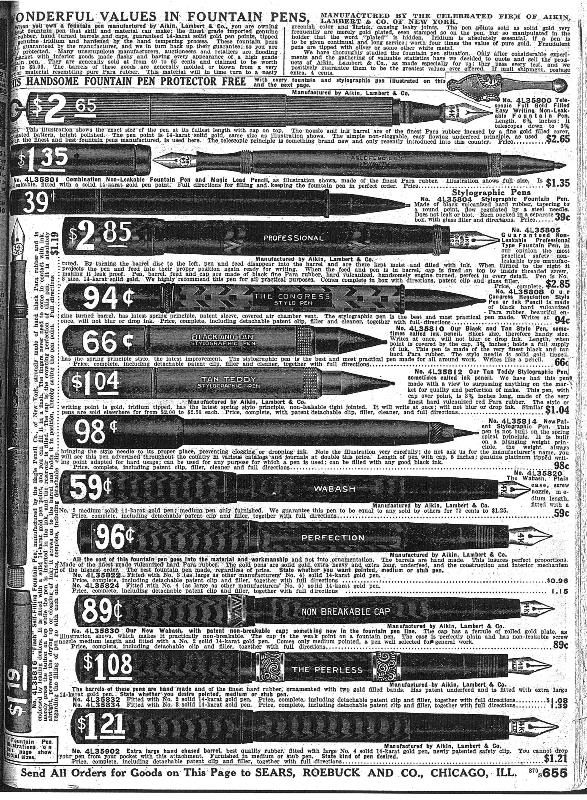
Spring 1924 - the first Webster pens - look at that big one at the bottom - Wirt anyone?
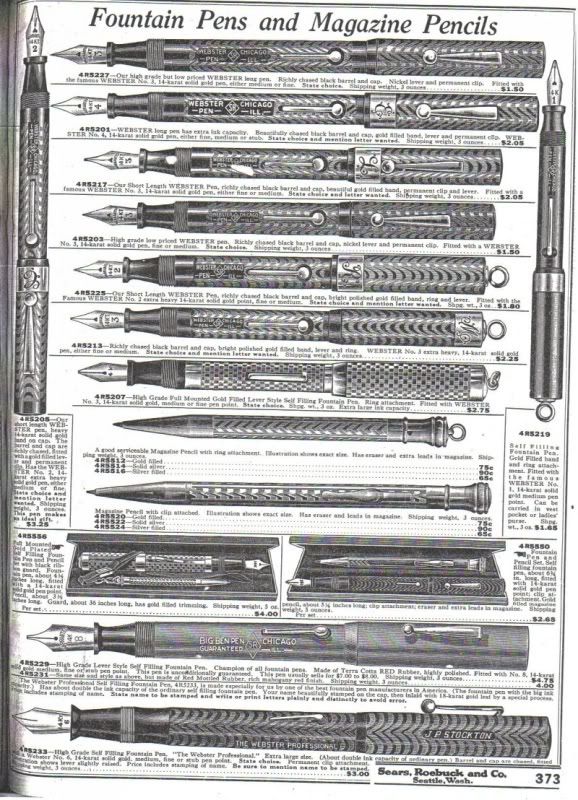
Good Service pens, Fall/Winter 1927-28 catalog.
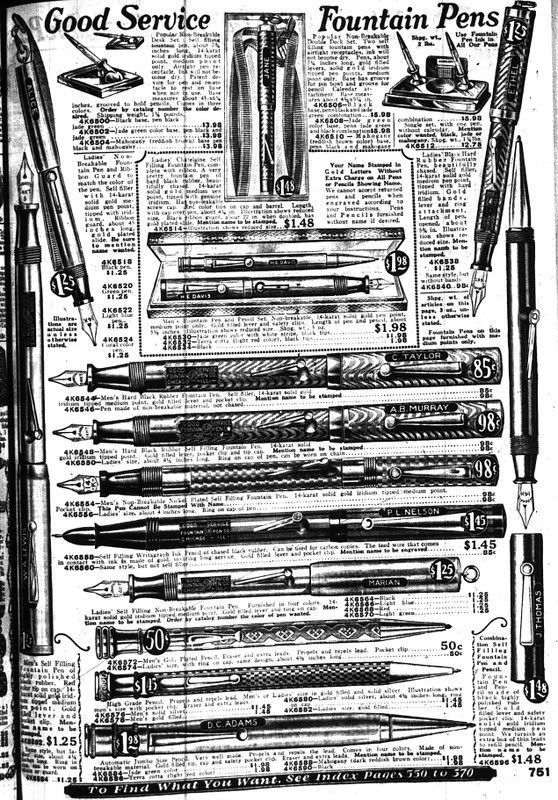
Diamond Medal, Spring 1927
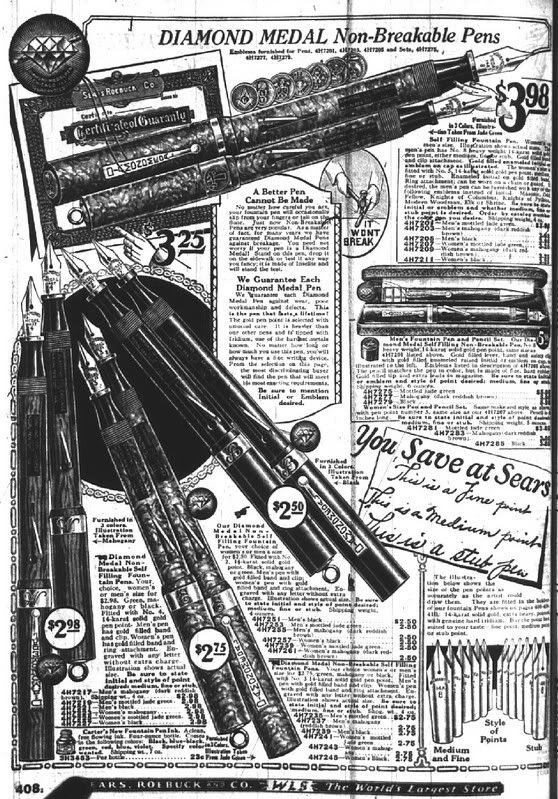
Diamond Medal, Fall/Winter 1927-8 catalog
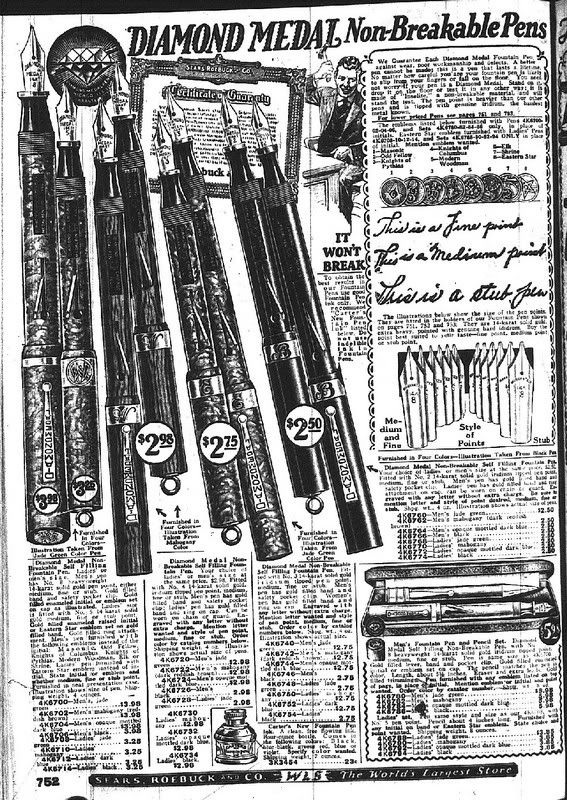
Webster, Spring 1927 catalog
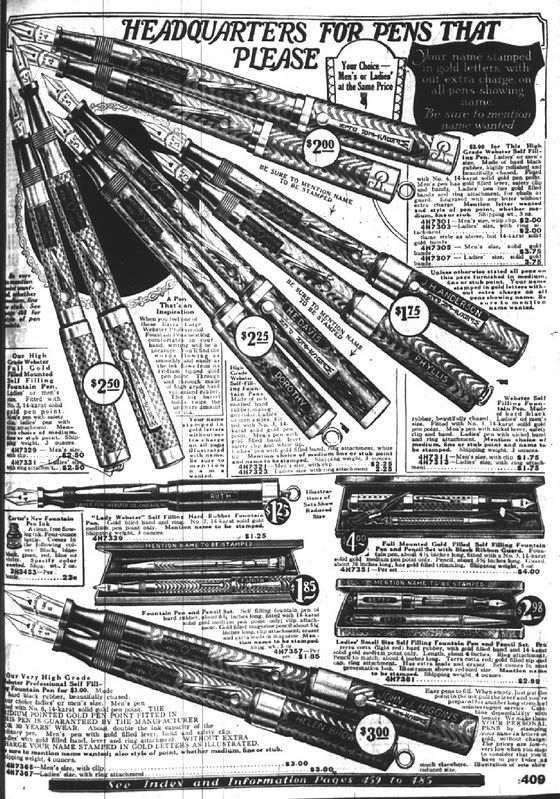
Good Service, Spring 1932 - ever see those little triangle nibs, or floral clips before? I actually have an empty bottle of the Diamond Medel ink.
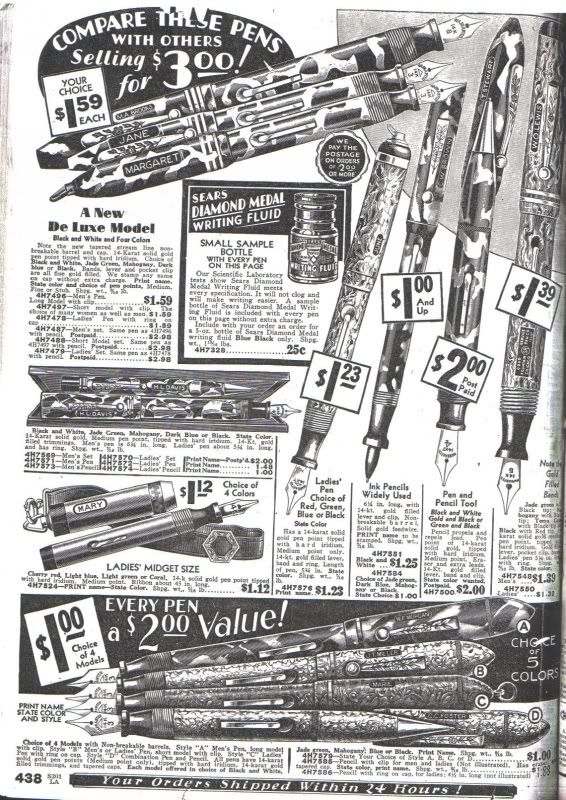
And the Diamond Medal Comrade, Spring 1932:
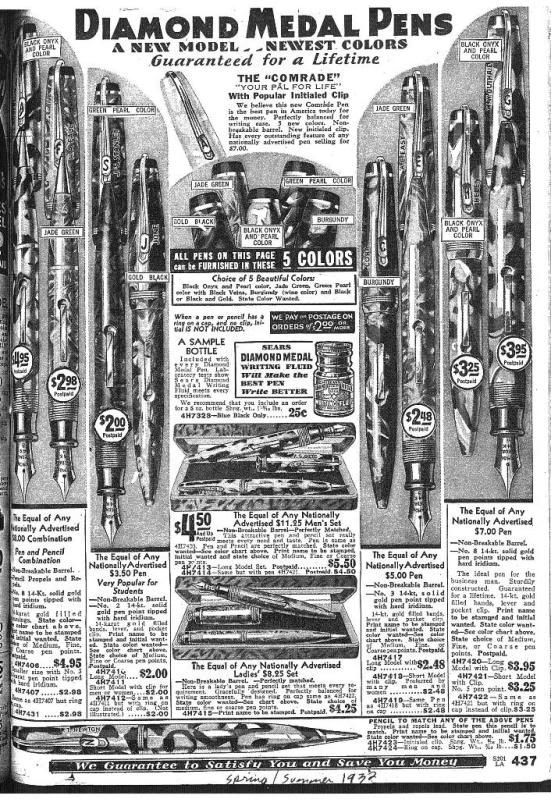
The aforementioned Good Service bulb-fillers from the Fall-Winter 1936-37 - not sure who made these, but the Websters are unmistakably "rebadged" Parker Challanger's.

#934 Pics o' the gold brick. Funky Parkers from the 'thoities,
![]() Posted by
J Appleseed
on 02 August 2010 - 08:59 PM
in
PARKER: (USA "Big Five")
Posted by
J Appleseed
on 02 August 2010 - 08:59 PM
in
PARKER: (USA "Big Five")
Well, you know how to entice me to join this little forum of yours. But really David - you revealed most of this in the FPN post, so the little teasing shots seem a bit redundant. We've seen it before and then some.
As for what is early or late for DM, it is all cataloged. If there is one thing we know about these Sears pens is that they were well cataloged, and the catalogs are not too hard to find (though I confess I have not had the library time that I wish I had).
Not to spoil the fun, but here are some of the catalog pages from Spring 1935, Fall 1935, and Spring 1936. I have some 37 or 38 cat. pages in my files at home, but don't have scans with me at the moment. I don't believe that the "web" or brick pattern appears in the 38 catalog, so that would give you an idea of "late".
Some additional observations on the various rebadged Parkers:
In addition to the date codes, which also appear on challanger-like mid-30s Webster and possible Good Service pens (have to check the latter), the Diamond Medal pens also advertised the 2-sided nature of their nibs.
Websters and DM pens generally maintain a 3-band style throughout the line.
The first year or so of DM pens saw "Sacless Vac-Fill" pens being sold alongside button-filled Diamond Medal "Non-transparent Sac-fil" pens with the same colors and trim, and only $1.00 less. So while the Parker brands kept the Vac-fil as a unique higher-tier pen and the button-filled Challengers as a tier below the Vac-fil pens, the DM pens mixed the two.
Sears higher-quality pen brands at this time period consisted of Diamond Medal, as a top-line, Webster, as middle-line, and Good Service, as a lower end, but still quality pen (mostly, though not always 14K nibs, and price-point around $1).
Sears also used the budget brands Truepoint and Tower-Truepoint, later just Tower (playing on the Sears Tower, which at one point was the tallest building in Illinois), as well as un-branded budget pens. Some of the allegedly unbranded pens had Ambassador levers. Some of the Truepoints are clearly in the same family as the other presumptive National Pen Products co. Pens, others are identical it Eagle pens of the time. I don't think any of the Truepoints were made by Parker (but if the Fifth Avenue pens, by the "Stafford Pen Co." were made by Parker, I suppose anything is possible).
Finally, on the Fifth Avenue Pens - these were in fact made by Parker for Woolworths (at least in the early-mid 1930s). Not only were they different than other Parker brands, they were made with reclaimed materials and scraps, and employees that made them were paid less than the mainline Parker employees. Austensibly the reason was just to try to provide some sort of jobs to people in the bottom of the Depression. It also seems to have been a starting position, and better performing employees could be moved to the main Parker products.
I think the story behind the Fifth Avenue Pens (which is based on a shop-floor employees recollections, so should not be assumed to represent Parker Management thinking) gives a clue as to why Parker was willing to sell rebadged Parkers through outlets like Sears and Woolworths. It was the depths of the depression and companies like Parker were desperate to get whatever market share they could. The Sears house-brands were probably a ripe prize, and at $4.95, they were not that much less than the Parker Juniors.

Spring 1935
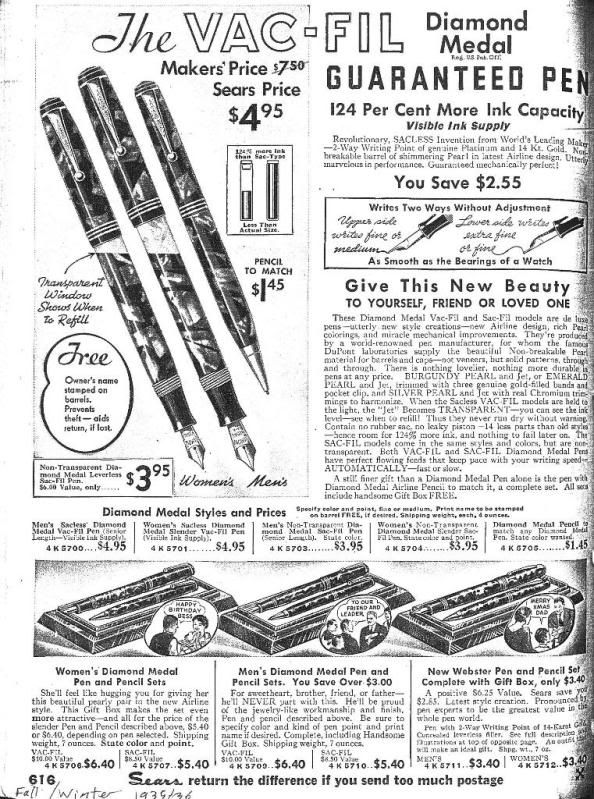
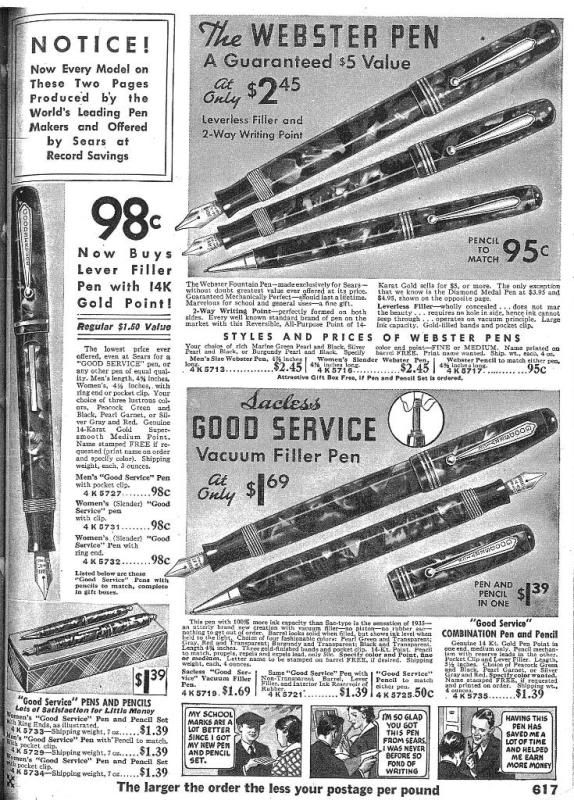
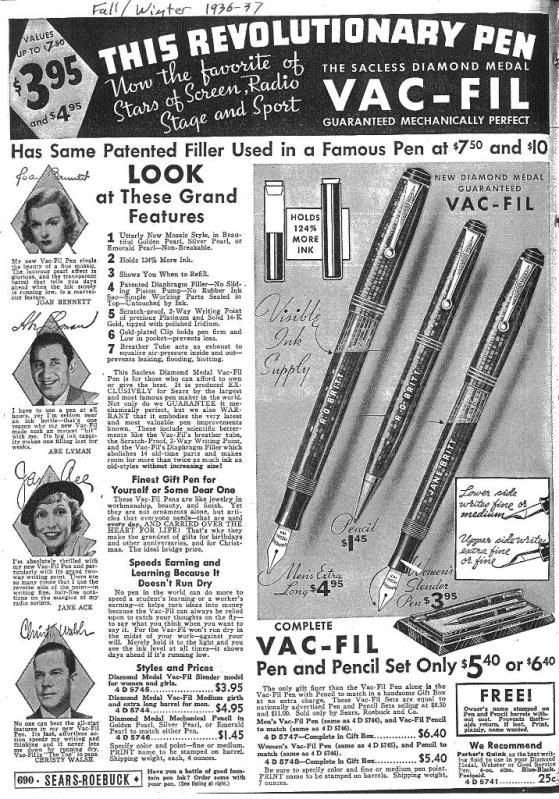
The second pen from the left (already sold) in Richard Binder's Pen Tray for August is a silver pearl Parker/Diamond Medal. Is it Shadow Wave plastic or something else entirely? Would love to see a close up...
It is not a Shadow Wave plastic, but something else entirely. It is a striated grey, similar to the Sheaffer grey striated pattern, but more stripe-like - see the funny green striped Parker at the beggining of this thread for the green version. I think I have it in the 1938 catalog, but have to check when I get home. I have one of these in grey the slender size, incidentally, though I haven't had a chance to shoot a pic.
Also, here is a picture of the faceted button filler that appears in the Spring 1935 catalog page. I don't think Parker made anything comperable (fluted, but positioned as a top-line pen).
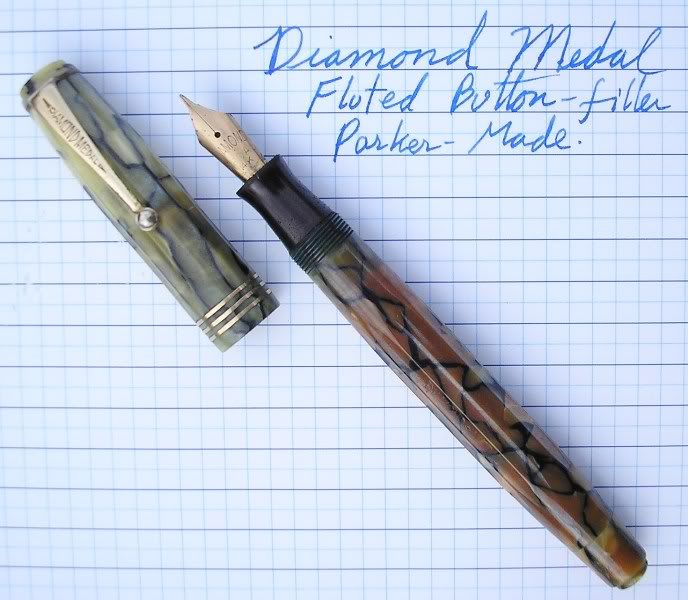
- Fountain Pen Board / FPnuts
- → J Appleseed's Content
- Privacy Policy



